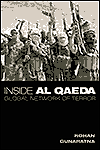|
| Home | About Kashmir Herald | |
Volume 3, No. 3 - August 2003 |
|
| Featured Article |
|
|
|
Flawed Secularist Argument (Part
II) NC and the Pandit minority in 1947 Dr. Ajay Chrangoo How does the credit of ‘saving’ the Hindu minority of Kashmir go either to Sheikh Abdullah or the NC? Was not the Sheikh’s position more precarious than that of the Hindus of the Valley? Were the hundreds of thousands of Hindus and Sikhs in the now Pakistan occupied part of the state saved by Sheikh’s activists in those areas? No, they were massacred in their own places most brutally. Did not the locals join the bands of the tribals when Baramulla fell and these marauders spread out in the rural areas singling out the Hindu and Sikh houses and families and subjecting them to loot, rape and killing? It is true that top NC leadership did not promote direct violence against Pandits. Had it done so, Nehru would have found it difficult to bail out Sheikh Abdullah, in the heat of partition aftermath. If the Sheikh’s slogan of Sher-i-Kashmir Ka Kya Irshad etc. had made any real impact on the Muslims of Kashmir, their response to the savagery of the raiders would have been totally different. By the same logic we can say that if the Muslims of the Valley really believed in and acted upon what they called Kashmiriyat, then they would not have provided all conceivable logistic support to the armed Islamist insurgents in the ongoing situation. This falsifies the oft-repeated excuse “We have guns on both sides, what can we do”. The gun on one side is by choice and also the result of not resisting the ideological imposition. Such was the impact of communal violence in 1947 that in Baramulla district no fewer than half of the Hindu and Sikh population was either killed or forcibly converted (even if only temporarily) or obliged to leave their homes and hearths for good. The slogan of secularism was the key to induce the visionaries of New Delhi to throw their full support in favour of Sheikh Abdullah. Never before has this double edged weapon been used so effectively by any politician in the subcontinent. The only intellectual who could penetrate into the mind of the Sheikh in those fateful fears was Prem Nath Bazaz, of course his friend, colleague and political sympathiser. Sheikh Abdullah as the torch bearer of secularism Sheikh Abdullah, as a popular leader of a majority region (by which we mean the state of J&K) did not fall outside the Muslim League leadership’s perception of Muslim majority region leadership. It has to be noted that the Muslim League primarily represented the interests of Muslims in minority provinces and feudal-salariat groups. The conflict between the League and the Muslim leadership in Muslim majority provinces was resolved only after 1946. Active role of GM Syed (in Sindh) and the Unionist leaders in the Punjab in the affairs of the League thereafter and overtures of Sheikh Abdullah to the Muslim League were part of the same process. W.C. Smith, the noted historian, in his seminal work, ‘Modern Islam in India’, rightly notes that Sheikh Abdullah was not superceding Muslim subnationalism in larger Indian nationalism but was on the contrary undercutting it still smaller local loyalties, expressing as Kashmiri Muslim subnationalism.” We have already noted that so far nobody has tried to address fundamental issues in relation to NC’s commitment to secular nationalism. One of the tasks of far reaching consequence which Sheikh accomplished when in power was to carve out Gool Tehsil in Reasi, Doda district in Jammu region and Kargil district in Ladakh division. Nothing but communal undertones justified this machination. The people quickly realised how the administration looked at things. Exacerbation of communal tension in otherwise prosaic societies of these regions was engineered. In 1978 during the second stint of the Sheikh, gerrymandering of electoral constituencies pushed the minority groups, Gujjars, Shias and Pandits to the political Junkyard and established firmly the dominance of the Sunni Muslims of the Valley. The crowning act of non-secularist character was the introduction in the Legislative Assembly the most dangerous Resettlement Bill in 1982. As leader of the ruling party, he piloted the bill. The official record of the debate will show the vicious communal undertones at work when member after member from the treasury benches supported it fiercely. Even a cursory glance on the pamphlet ‘Kashmir Mein Aksariyata Ko Aqalliyat Me Bedelne Ki Sazish’, published by ruling NC gives the background in which the Resettlement Bill was drafted. This pamphlet, highly treasonable and provocative (it was later on withdrawn after having seen limited circulation) gave clear indications that the NC was anything but a secularist group. The aftermath of NC attack on Jamaatis in the Valley in the wake of the hanging of ZA Bhutto, brought about a radical change both in the precept and the practice of NC. Here the Wahabi element exported by the Saudis came to play its role in Kashmri and the Sheikh’s role during this period needs to be refocussed. Islamising the historical names of nearly 800 places in Valley, and Sheikh Abdullah’s speeches at Ganderbal in 1978 and at Hazratbal in 1982 do not portray Sheikh Abdullah as an outstanding secularist. Secularism has become a much profaned word. Conventional secularist wisdom recognises communal violence particularly the major conflagrations only as manifestations of communalism. Subtle and often imperceptible undermining of the interests of the religious minorities are no less detrimental socially and politically. Pseudo-secularists characterize the present secular breakdown in Kashmir as an aberration and hence ignorable. But it is here where once must dig deep into social phenomenon to arrive at the root of the problem. Communal violence is only the flash-point of communalization process, which can be subtle, slow and lengthy. Communal violence is contingent on a number of factors like a) size of the minority b) minority’s attitude to assault on its cultural, political and economic rights c) its cohesiveness d) its vote-bank potential. Smaller numbers, peaceful disposition, non-retaliatory behaviour, historicity of cultural values and its non-votebank structure explain the relative absence of large scale communal orgy. Communal riot is a situation where the two communities not numerically highly disproportionate attack each other. Even 1986 program against Pandit minority at Anantnag was more of a communal aggression, where violence went only one way. Even if no minority member was killed, yet the scale of attack on minority property and places of worship was comparable to any major riot. What then were the visible manifestation of communalism in Kashmir? These were individual attacks on community members, kidnapping and forcible conversion of Pandit girls, raking up false disputes over Pandit places of worship, grabbing of Pandit property through politico-administrative connivance and erecting boards of Maqbooza Ahle-e-Islam on disputed or unattended Pandit land, attacks on and desecration of Pandit places of worship. Even known left wing Pandit activists like Tej Bahadur Bhan and HN Wanchoo were not spared by the rank fundamentalists. In 1986 in many villages of district Pulwama and Baramulla and also earlier at other places call for boycott against the Pandit minority was given. And whosoever won or lost the Indo-Pak cricket match, the Pandit became the hapless victim of Vandalism by the majority community hooligans. Their holier-than-you wards, looked on in gleeful sadism. The exodus of the Pandits inter-mittently from 1947 till the mass exodus in 1990 is the result of a carefully drawn plan of ethnic cleansing. This passed on as ‘Kashmiriyat. Dr Farooq Abdullah government’s strong Pandit-bailting in 1983-85 period and totally hostile attitude against exiled community, aimed at destroying Pandits’ roots for ever in Kashmir is in itself an eloquent commentary on subtleties of communalisation process in the ‘secular crown’ of India. Modern Muslim elite and mainstream political groupings in Kashmir have not lagged behind fundamentalists in fomenting communal hatred against religious and ethnic minorities. It is this leadership that is busy pursuing apartheid against displaced Kashmiri Hindus and is creating obstacles in Pandits’ complete and sincere return. Its public posture on Pandits’ return is for the consumption of Indian public. (Concluded) Courtesy: Kashmir Sentinel |
 |
 |
 |
|
|
Archives
| Privacy Policy |
Copyrights
|
Contact
Us | |
||